
The Solar-Terrestrial Centre of Excellence (STCE) is a collaborative network of the Belgian Institute for Space Aeronomy, the Royal Observatory of Belgium and the Royal Meteorological Institute of Belgium.
 |
Published by the STCE - this issue : 5 Jul 2012. The Solar-Terrestrial Centre of Excellence (STCE) is a collaborative network of the Belgian Institute for Space Aeronomy, the Royal Observatory of Belgium and the Royal Meteorological Institute of Belgium. |
| Archive of the newsletters | Subscribe to this newsletter by mail |
Solar Orbiter is intended to brave the fierce heat and carry its telescopes to nearly one quarter of the Earth's distance from the Sun, where sunlight will be thirteen times more intense than satellites in the vicinity of the Earth feel it. The spacecraft must also endure powerful bursts of atomic particles from explosions in the solar atmosphere. The reward will come in the form of sharp images obtained together with unprecedented measurements of the local near-Sun phenomena.
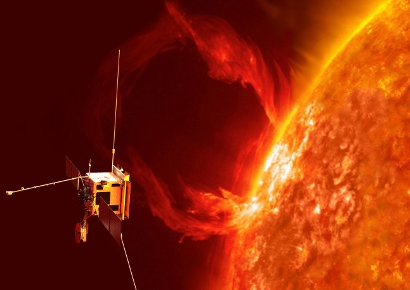
Solar Orbiter is currently scheduled to be launched in 2017. However, there are quite some challenges for a spacecraft operating in such a harsh environment. Therefore, meticulous preparation of the mission is required, with several workshops being organized.
The Fifth Solar Orbiter Workshop will take place in the medieval city of Bruges (Brugge) in Flanders/Belgium on September 10-13. All information on this conference can be found at http://www.stce.be/solarorbiter5/. A first iteration of the scientific program with the invited speakers can be found here http://www.stce.be/solarorbiter5/program/program.php
Now would be a good time to register and submit your abstract for a talk and/or poster. The abstract submission deadline has been extended to July 15. Authors will be notified by July 28. Bruges is a city with high touristic appeal, so make sure to book your hotel well in advance.
The conference poster can be found underneath. It was created by Wim Vander Putten from the Planetarium, Heizel, Belgium. Please give it maximal visibility.
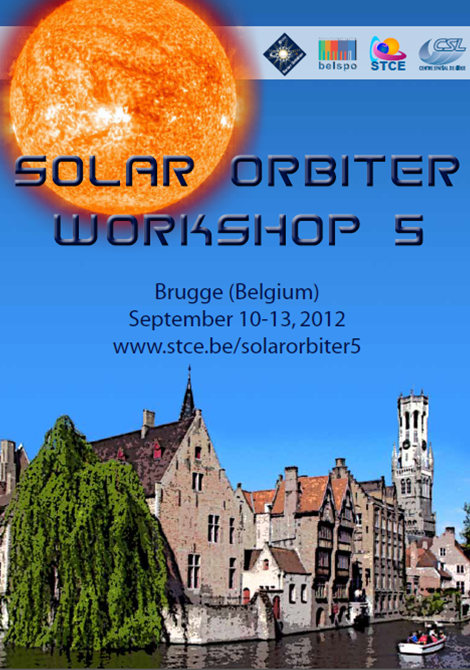
Sometimes, it happens that a sunspot group appears simple in white light, yet it proves to be quite active when it comes to the production of medium or strong x-ray flares.
Such was the case for NOAA 1513, which appeared on 26 June at the north-east limb. This bipolar sunspot group only displayed one mature sunspot, and a few small spots without penumbra. A typical outlook can be seen in this drawing made on 29 June using the white-light telescope of the Uccle Solar Equatorial Table (USET , http://www.sidc.oma.be/uset/index.php ). See figure underneath at right, showing NOAA 1516 (left) and NOAA 1513 (right).

The SDO/HMI magnetogram (figure above, at left) shows the main spot of this region in black magnetic polarity, at about the same time as the white light observation. Upon careful examination, one can see some white dots close to NOAA 1513's main spot. These dots indicate opposite magnetic polarity, and some of them correspond to the small sunspots visible in the white light drawing. Normally, this is OK, but these spots are really close to the main spot, inviting to short circuiting. This is comparable when one comes out of an easy chair and wants to touch something metallic: Only when the hand is close enough to the metal, a small spark ignites. On the Sun, this happens when magnetic field of opposite polarity come close enough together. The resulting "sparks" have of course astronomical proportions.
In the case of NOAA 1513, this magnetic configuration resulted in several eruptions. In fact, this sunspot group produced 14 C- and 5 M-flares during its 6 days that it was visible last week. That is on the average about 2 small and 1 medium flare every day! Quite an accomplishment for such a small group.
The figure underneath shows one of the medium flares in action (M1.6 peaking at 18:32UT on 30 June). The 4 images on the left show the Sun in H-alpha (relatively cool, lower atmosphere of the Sun), as imaged by the GONG H-alpha Network ( http://halpha.nso.edu/ ). The 4 images on the right show magnified images taken by the PROBA2-spacecraft ( http://proba2.oma.be/ssa ). Its SWAP instrument is observing in the much hotter upper atmosphere of the Sun ("corona"), explaining the huge difference in outlook between the two series. The 4 pairs of pictures were taken in intervals of about 8 minutes, starting at 18:24UT.
As expected, the explosion occurred in the area of opposite magnetic polarities, i.e. to the west and to the south of the main spot. The two bottom pairs of pictures also show some dark material being ejected. No material seems to have left the Sun though, as no CME-signature was detected by the SOHO-coronagraphs.
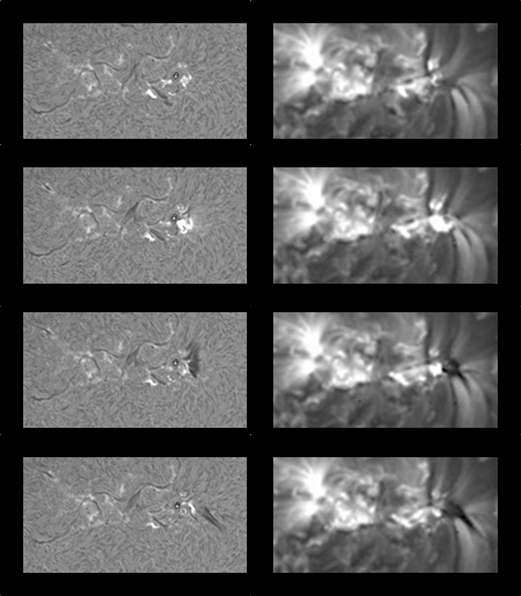
Solar activity was very low in the beginning of the week, with only two B flares on June 25. The flaring activity gradually rose to M flare levels, mainly as a result of flux emergence in NOAA AR 11512, 11513 and 11515. June 28, 29 and 30, and July 1st each featured at least one M flare. In total, 35 C flares and 5 M flares were observed.
| DAY | BEGIN | MAX | END | LOC | XRAY | OP | 10CM | TYPE | Cat | NOAA | NOTE |
| 28 | 1607 | 1612 | 1615 | N16E45 | M2.4 | 1B | 0 | III/2 | 96 | 1513 | |
| 29 | 0913 | 0920 | 0922 | N17E37 | M2.2 | 1B | 0 | III/2 | 96 | 1513 | |
| 30 | 1248 | 1252 | 1254 | N17E21 | M1.0 | 1N | 0 | III/3 | 96 | 1513 | |
| 30 | 1826 | 1832 | 1834 | M1.6 | 0 | III/2 | 96 | 1513 | |||
| 1 | 1911 | 1918 | 1921 | N14E04 | M2.8 | SB | 66 | V/3 | 96 | 1513 |
| LOC: approximate heliographic location | TYPE: radio burst type |
| XRAY: X-ray flare class | Cat: Catania sunspot group number |
| OP: optical flare class | NOAA: NOAA active region number |
| 10CM: peak 10 cm radio flux |
Solar Activity as recorded by SWAP and LYRA
This week, the Sun’s activity level went from *low* early in the week up to *moderate* from Thu on until the end of the week.
5 M-level flares occurred during the last 4 days of the week - SWAP pictures and LYRA curves below:
SWAP Image - M2.4 flare on Thursday 28/06
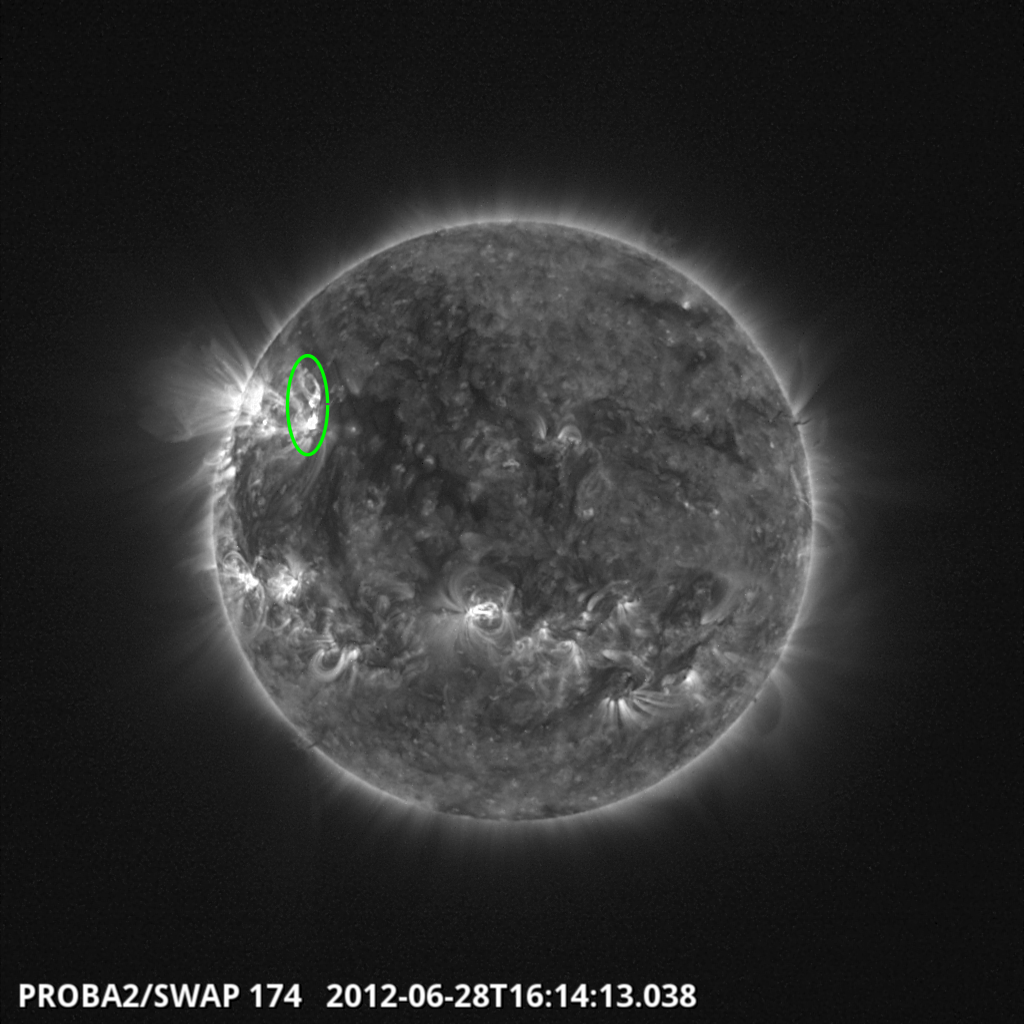
LYRA Curves - M2.4 flare on Thursday 28/06

SWAP Image - M2.2 flare on Friday 29/06
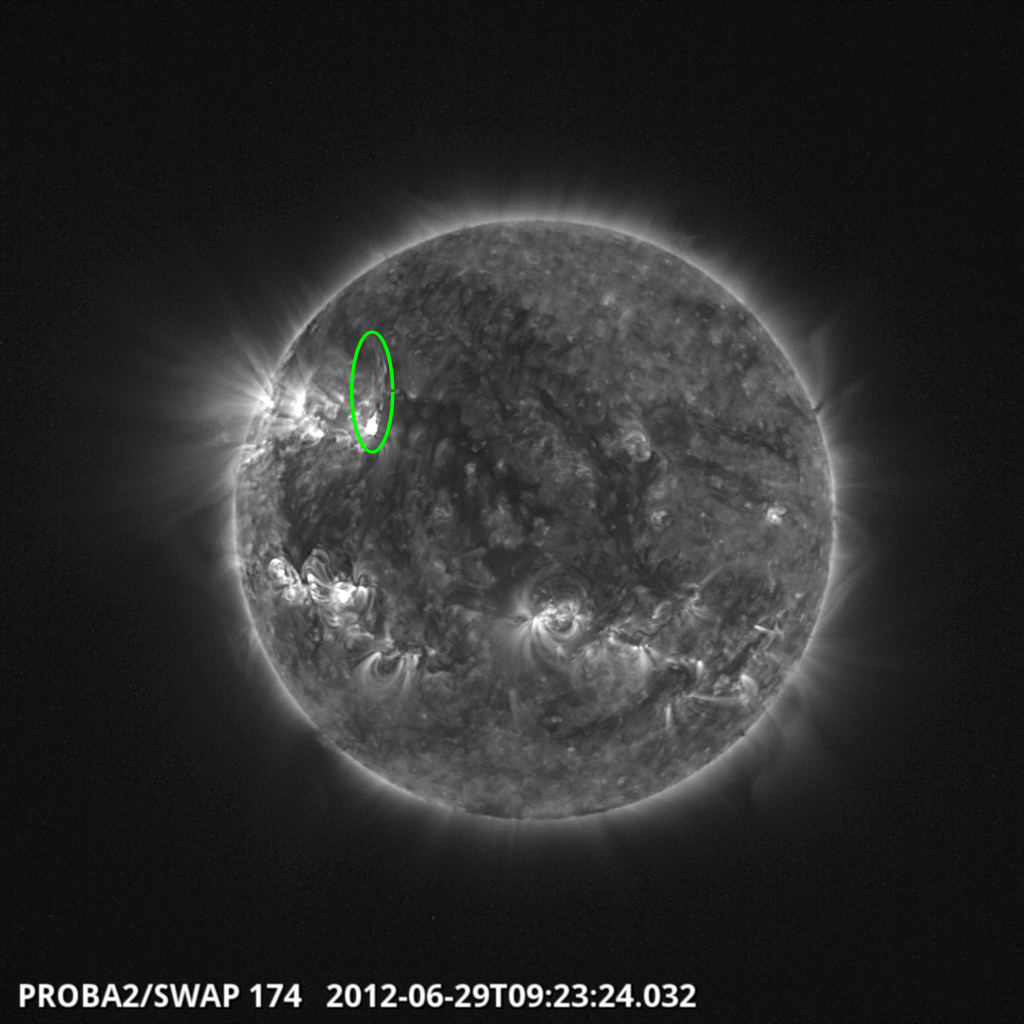
LYRA Curves - M2.2 flare on Friday 29/06
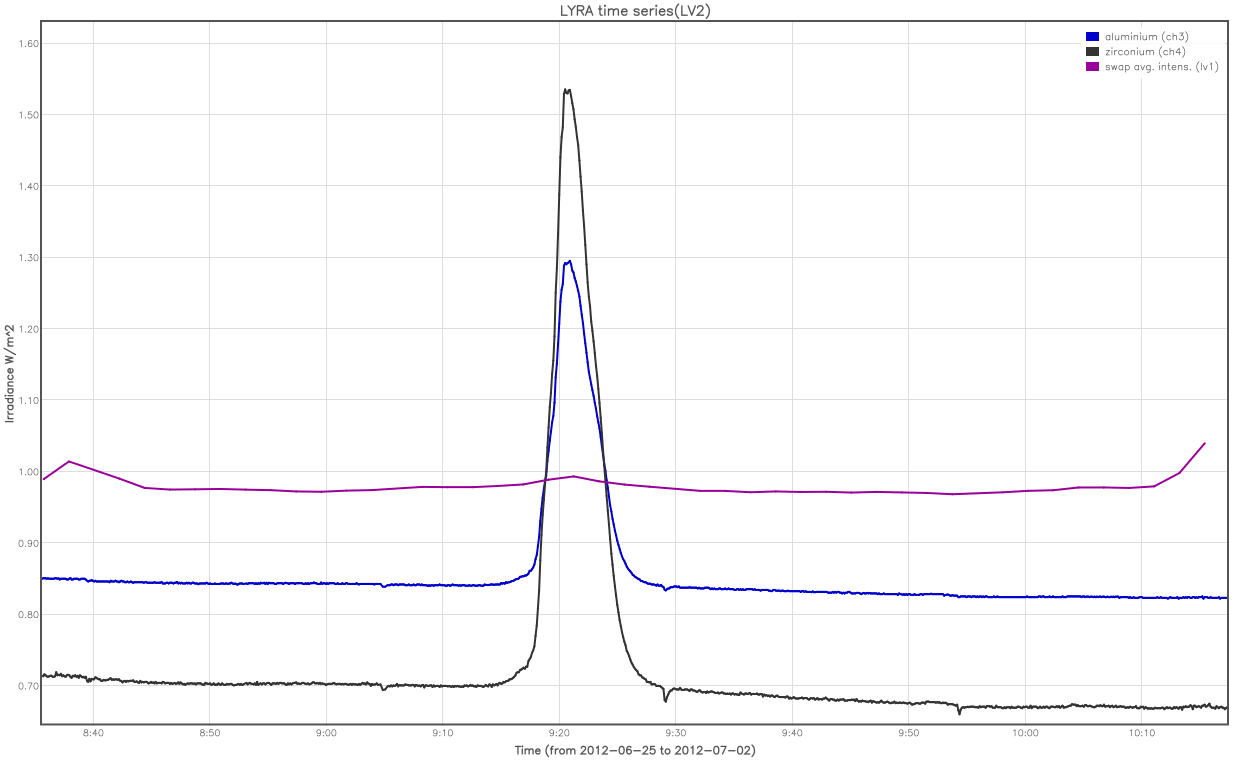
SWAP Image - M1.6 flare on Saturday 30/06
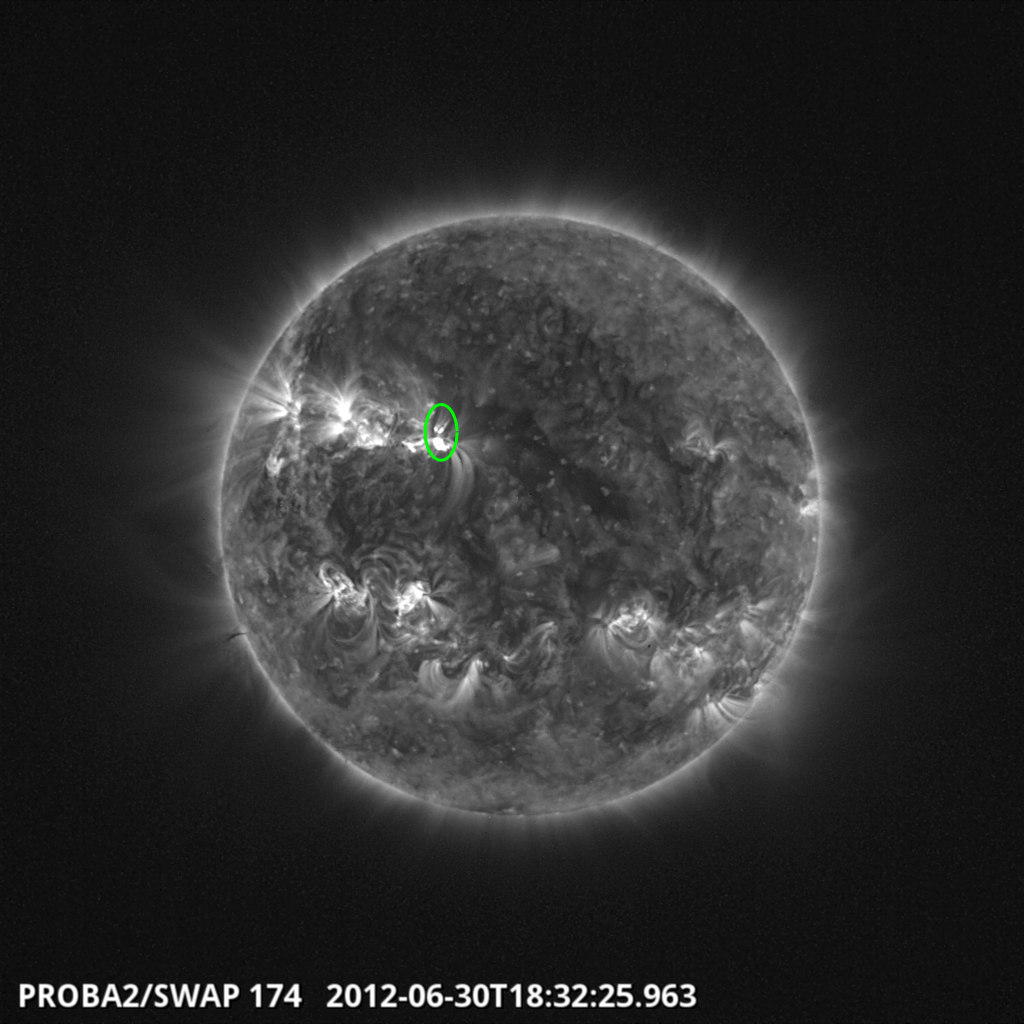
LYRA Curves - M1.6 flare on Saturday 30/06
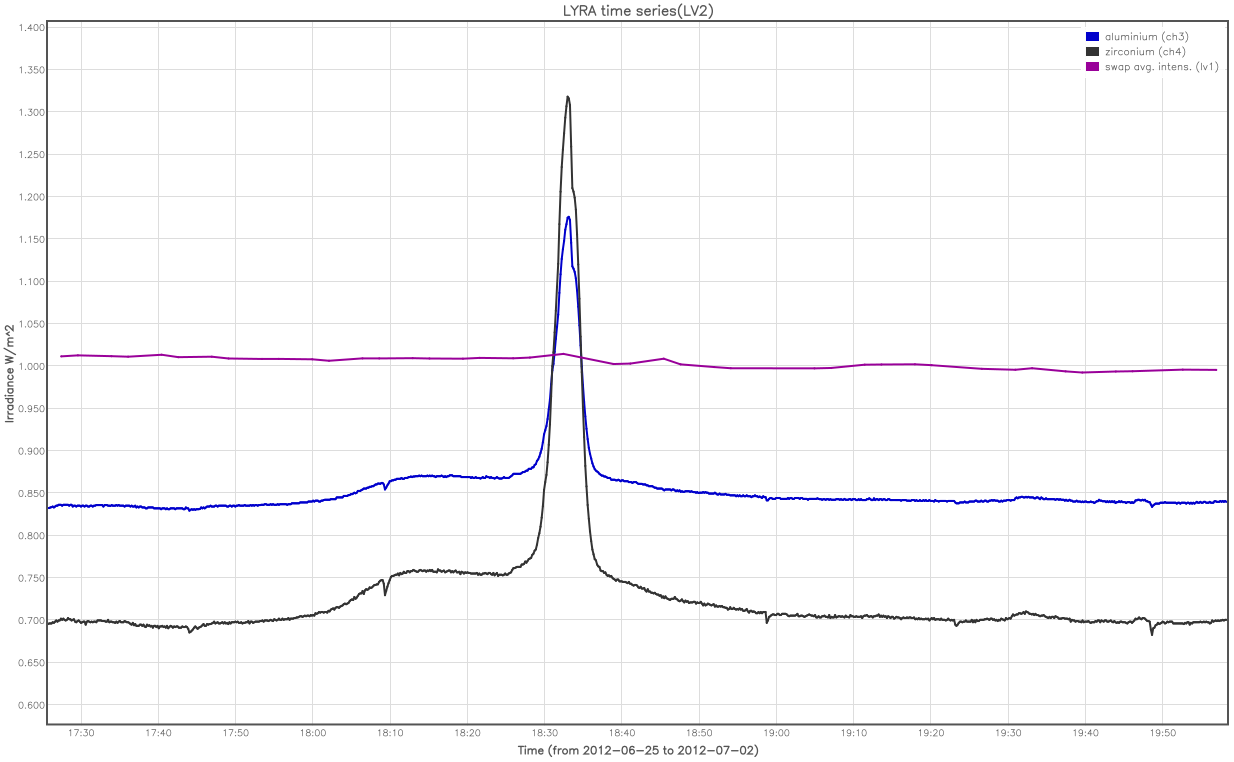
SWAP Image - M2.8 flare on Sunday 01/07
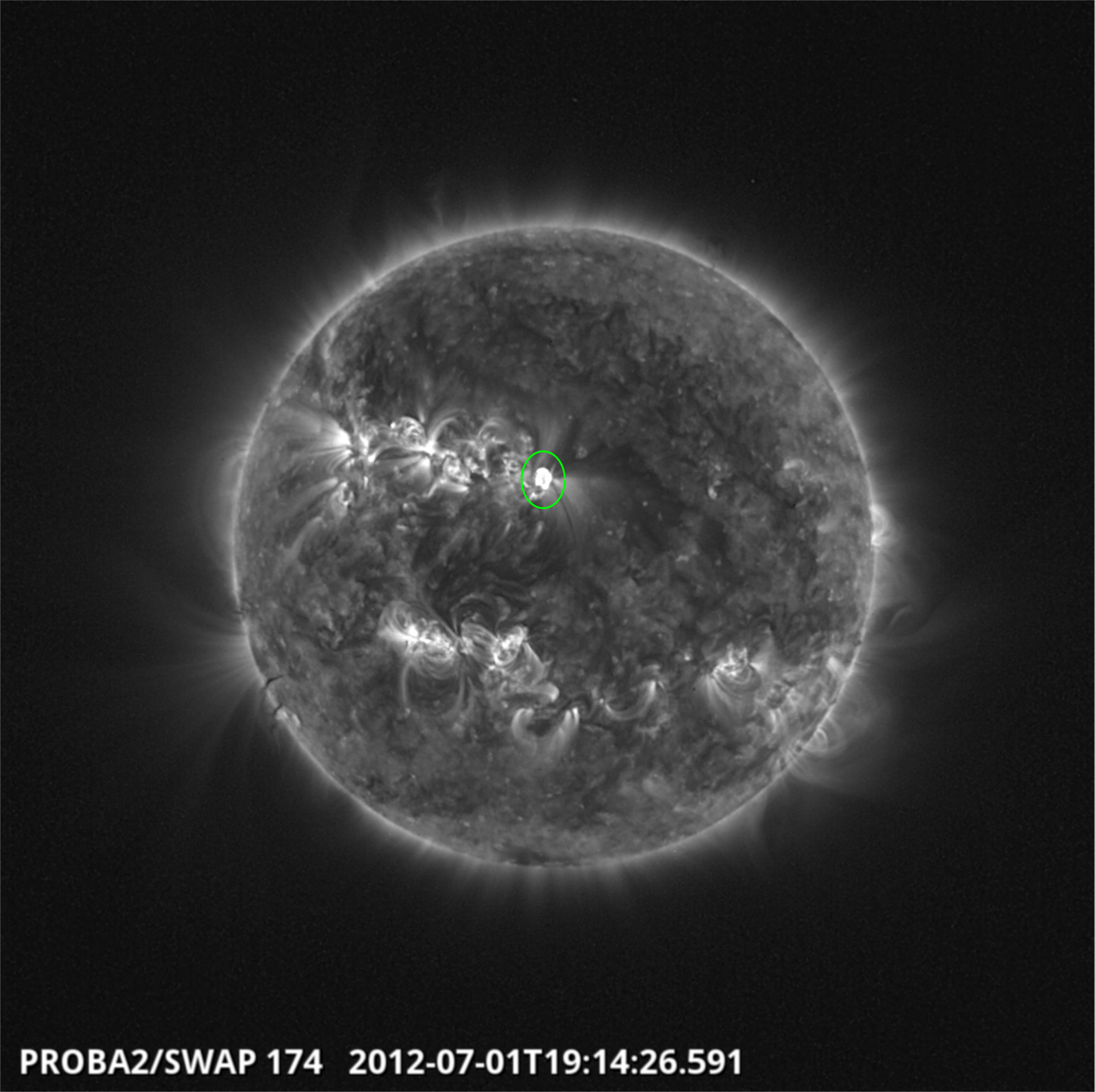
LYRA Curves - M2.8 flare on Sunday 01/07
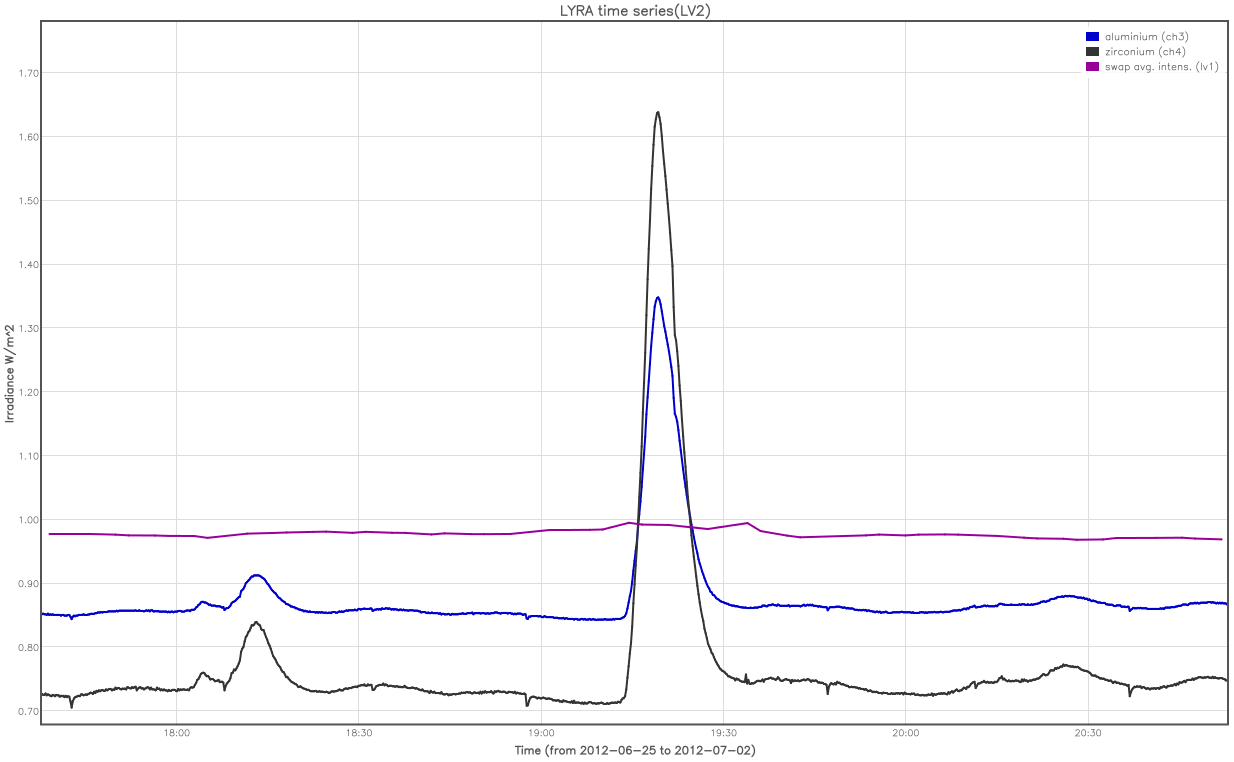
Geomagnetic activity was quiet (K Dourbes less than 4) until the arrival of an expected coronal hole high speed solar wind stream in the early UT hours of June 30. Solar wind velocity increased gradually from about 400 km/s to a plateau of about 700 km/s while Interplanetary Magnetic Field strengths between 5 and 15 nT were observed, with the Bz component sometimes reaching -10 nT for short periods. Decreasing solar wind density around 16:00 UT on June 30 indicated the transition from stream interface to the coronal hole high speed stream itself. Meanwhile, the Interplanetary Magnetic Field had stabilized around 5 nT. The geomagnetic field responded with a few intervals of active geomagnetic levels (Dourbes K and NOAA Kp = 4) on June 30 and July 1st.
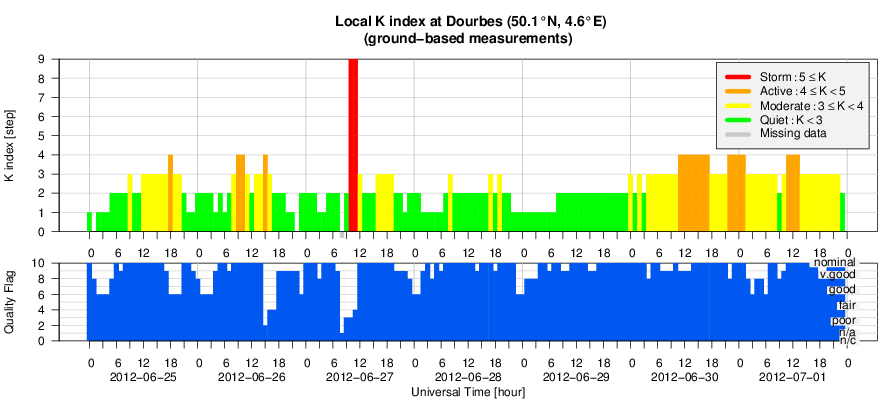
This is the wrap up of the work presented during the workshop 'Retrieval of Aerosol Properties from Satellite and Ground-Based Measurements' that was organised in the frame of the STCE annual meeting 2012.
http://www.spaceweather.eu/en/repository/show?id=192
The presentation is the avant première of the workshop 'Water vapour, meteorology and climate' that will be organised in the frame of the STCE annual meeting 2012.
http://www.spaceweather.eu/en/repository/show?id=210
This is the wrap up of the work presented during the workshop 'Radio Science' that was organised in the frame of the STCE annual meeting 2012.
http://www.spaceweather.eu/en/repository/show?id=211
The 'Highlights, opportunities and challenges' presented during the STCE annual meeting 2012.
http://www.spaceweather.eu/en/repository/show?id=212
Start : 2012-07-08 - End : 2012-07-11
The 23rd Annual NASA
Space Radiation Investigators'
Workshop will be held July 8-12, 2012, at the Washington Duke Inn,
Durham, North Carolina. The purpose of this workshop is to provide
an opportunity for active researchers in the NASA
Space Radiation Program to share
the results of their work and to explore new directions for
research that may benefit the NASA
program. The workshop format will
include plenary sessions, poster sessions, and a poster contest to
recognize and honor student investigators. In addition, there will
be special sessions on space physics and technology allowing
opportunities for a comprehensive discussion on NASA's overall
space radiation protection goals.
Principal investigators receiving NASA
funds (including those from the
NASA
/DOE joint program and the NSBRI)
are required to attend; principal investigators funded by the
Department of Energy are strongly encouraged to attend. Although
attendance at the workshop is by invitation only, other scientists
with a legitimate interest in space radiation research are also
welcome. If you wish to attend, please send your requests directly
to
. Requests should be accompanied by an explanation of
your relationship to the Space Radiation Program and the type of
contribution you wish to make.
Website:
http://www.dsls.usra.edu/meetings/radiation2012/
Start : 2012-07-11 - End : 2012-07-15
From 11th-15th of July 2012 international researchers, policy
makers, business leaders and global media will gather in the
Convention Centre in Dublin, Ireland to take part in the
Euroscience Open Forum (ESOF), 2012. A science conference like no
other, ESOF 2012 is unique in representing the largest convergence
of the Sciences, Humanities and Culture in Europe in 2012. Some of
the keynote speakers at ESOF 2012 will include Craig Venter,
Rolf-Dieter Heuer, Charles Bolden, Mary Robinson, and Bob
Geldof.
Website: http://www.esof2012.org/
Start : 2012-07-14 - End : 2012-07-22
The 39th COSPAR Scientific Assembly will be held at the Global
Education Centre, 2 Infosys Training Centre Mysore, Karnataka India
from 14 - 22 July 2012. This Assembly is open to all bona fide
scientists.
Website:
http://www.cospar-assembly.org/
Start : 2012-07-16 - End : 2012-07-27
The CISM Space Weather
Summer School is a 2-week intensive
program targeted to first-year graduate students but also attended
by undergraduates and space weather
professionals. The daily schedule
includes morning lectures, followed by afternoon laboratory
sessions where students further explore the day's topics using
CISM model simulations, observational data, and sophisticated
visualization tools. CISM is making the laboratory materials
publicly available for use by others, for example to supplement
lecture courses or for student independent study. The deadline for
applications is May 1.
Website:
http://www.bu.edu/cism/SummerSchool/overview.html
Start : 2012-07-23 - End : 2012-07-27
The Department of Astronomy and Geodynamics of the University of
Warmia and Mazury (UWM) is hosting the 2012 IGS Workshop.
This workshop will be composed or plenary sessions with invited
oral presentations, and afternoon sessions composed of poster
sessions and IGS Working Group splinter meetings. For this workshop
we are soliciting abstracts for the poster sessions.
The key dates for this workshop are as follows:
* Poster Abstract Submissions: March 25 - April 30, 2012.
* Registration: March 25- May 28, 2012.
* Hotel Reservations: March 25- May 28, 2012.
* Workshop: July 23 - July 27, 2012.
Website:
http://www.uwm.edu.pl/kaig/igs_workshop_2012/
Start : 2012-08-06 - End : 2012-08-10
The IRC's International Radiation Symposium 2012 provides a
forum for the scientific community to exchange recent results and
evolving ideas relevant to many areas of atmospheric radiation.
Quadrennially convened, the IRS assembles a global network of
scientists and students engaged in studies pertaining to the
Earth-atmosphere-Sun system, and encourages international
cooperation in radiation research crucial to understanding and
predicting Earth's dynamic climate and habitability. The IRC
invites you to Berlin and welcomes your participation in this
endeavor.
Website: http://irs2012.org/
Start : 2012-08-13 - End : 2012-08-17
An international body established since 2003, the Asia Oceania
Geosciences Society (AOGS) aims to promote geosciences and advance
its applications for the benefit of humanity in Asia and
Oceania.
Sessions:
* Atmospheric Sciences
* Biogeosciences
* Hydrological Sciences
* Ocean Sciences
* Planetary Sciences
* Solar & Terrestrial Sciences
* Solid Earth Sciences
* Interdisciplinary Working Groups
Website:
http://www.asiaoceania.org/aogs2012/public.asp?page=home.htm
Start : 2012-08-13 - End : 2012-08-16
You will have a noticed the slight re-branding of these
workshops from 'Image' to 'Information' processing. We think it is
time to expand the attention of these workshops to discuss more
generally how information about the Sun can be derived, stored,
shared, transformed and analyzed using appropriate techniques from
many other disciplines. We will still be covering image processing
and computer vision techniques applied to solar physics, but we
will also be including other topics such as machine learning, data
mining and new computing strategies. The re-branding simply
acknowledges and makes explicit what the community has been doing
to determine the physics of the Sun.
Link: http://www.sipwork.org/
Start : 2012-08-14 - End : 2012-08-17
There will be 7 sessions, with 2 invited speakers per session.
The following speakers have been invited to Hinode-6:
Website:
http://www-solar.mcs.st-and.ac.uk/~hinode6/Hinode-6/Welcome.html
Start : 2012-08-20 - End : 2012-08-31
In August 2012 China will for the first time host the General
Assembly of the International Astronomical Union in Beijing. This
triennial gathering of astronomers from around the world to discuss
and debate the most recent discoveries about the universe is an
important part of the vitality of our science. Astrophysics remains
one of the most exciting areas of human endeavor, and the venue of
the Beijing GA will be equally impressive: the new China National
Convention Center that is housed in the Olympic Park in a
beautiful, spacious building and area that is full of amenities for
conference participants and visitors.
The contributions of Chinese astronomy to human knowledge and
our understanding of the cosmos have been of historical
significance, from the earliest to modern times. GA participants
will have an opportunity to experience the wide range of
astronomical activities now taking place in China that include new
projects, facilities, and institutes. They will also report on, and
hear, the latest research results from every field of astronomy. An
exciting scientific programme is being developed that will hold the
interest of everyone. I am pleased to welcome all Union members and
invited guests to join us in Beijing for what will be a memorable
General Assembly.
Website:
http://www.astronomy2012.org
Start : 2012-08-22 - End : 2012-08-23
We are pleased to announce the Fermi Solar Data Analysis
Workshop to be held at Goddard Space Flight Center on August 22-23,
2012. Although primarily an Astrophysics observatory, the Fermi
Gamma-ray Space Telescope, and its Gamma-ray Burst Monitor (GBM)
and Large Area Telescope (LAT), provide unique capabilities in the
8 keV - 300 GeV band to monitor and study both the quiescent and
flaring Sun. Fermi has already made many observations of solar
X-ray and gamma-ray emissions, and many more can be anticipated
during the next few years with the peak in solar activity expected
in 2013.
This workshop is meant to be informal and interactive. It will
start with reviews of X-ray and gamma-ray solar studies to date,
including results already obtained with the Fermi observatory.
Extensive tutorials will be given on both GBM and LAT data analysis
techniques, with time set aside for hands-on practice on your own
laptop. We invite all of those interested in learning more about
Fermi's Solar capabilities, and interested in interacting with
experts in the field, to attend this 2-day workshop.
Website:
http://fermi.gsfc.nasa.gov/science/mtgs/workshops/da2012_solar/
Start : 2012-08-27 - End : 2012-09-21
The Solar and Space Weather
Network of excellence will hold its
first Summer School and Workshop in Tbilisi Georgia. The meeting
will focus on the first results achieved within the network and is
also open to the wider international scientific community involved
in solar and space weather
modeling, monitoring and
forecasting activities.
The Summer school will be open to all early-stage researchers
from the SOLSPANET member groups as well as to other young
scientists from institutes active in solar and space weather
studies.
The week of September 17-21 will be dedicated to the
International SOLSPANET-1 workshop. The workshop is also devoted to
the memory of the great Georgian scientists, professors Rolan
Kiladze and Avtandil Pataraya.
Scientific topics will include:
* Monitoring of precursors for solar flares and CMEs- solar
weather
* MHD waves in non-equilibrium medium
* Numerical and observational studies of CMEs
* CME
manifestation in the decametre
wavelength band
* Impact of space weather
on terrestrial life and
technological systems
* Advanced computational tools and knowledge base for better
solar and spaceweather forecasting
Website:
http://www.solspanet.eu/solspanet
Start : 2012-09-02 - End : 2012-09-08
The International School of Space Science of the Consorzio
Interuniversitario per la Fisica Spaziale organizes a Course on
"Astrophysical and Space Plasmas", to be held in L'Aquila, Italy,
September 02-08, 2012, and directed by A. Ferrari, M. Tavani, B.
Coppi and R. Rosner.
The aim of the Course is to present a comprehensive discussion
of the plasma
processes relevant to the
astrophsyical context, from low energy phenomena in planetary
systems to the very high energy objects recently discovered through
X and gamma ray observatories.
Introductory lectures will be dedicated to an analysis of
observations available from ground and space observatories
enlightening the thermal and non-thermal plasma
processes necessary for their
interpretation. At the same time the theoretical tools, analytical
and numerical, necessary for their interpretation will be presented
from an institutional point of view. Finally current models of the
astrophysical objects and phenomena will be discussed with
particular attention to the critical points with the objective of
selecting new research lines.
Website:
http://www.cifs-isss.org/
Start : 2012-09-10 - End : 2012-09-14
The Summer school is part of the training program of the Marie
Curie Initial Training Network TRANSMIT, funded by the European
Commission. Young scientists involved in TRANSMIT shall be trained
and educated for being aware and getting basic understanding of
ionospheric threats in different fields of application. Awareness
and knowledge of ionospheric threats is the starting point of
subsequent work to reduce or mitigate them in practical
applications.
Well recognized experts in their fields will give lectures to
better understand/learn about:
* Physical nature of ionospheric perturbations at all scales
* Ionospheric impact on radio wave propagation
* Detection/Monitoring of ionospheric perturbations
* Estimation the degree of ionospheric perturbation
* Mitigation techniques for avoiding threats in technical
systems
It is expected that lectures and discussions at the summer
school will help in particular early stage researchers to improve
their scientific work.
Website:
http://www.transmit-ionosphere.net/
Start : 2012-09-10 - End : 2012-09-14
We are pleased to announce that the fifth Solar Orbiter Workshop
will take place in Brugge, Belgium from Monday September 10 to
Thursday September 13. Friday September 14 will be dedicated to a
Science Working Team (SWT) meeting. The workshop will focus on the
science questions addressed by this exciting and recently approved
mission, which is a partnership between ESA
and NASA
. The scientific synergy of Solar
Orbiter with Solar Probe Plus and other missions will also be
highlighted.
Website:
http://www.stce.be/solarorbiter5/
Start : 2012-09-17 - End : 2012-09-22
The School of Astrophysics 'Francesco Lucchin' is addressed to
PhD students in Astronomy and Physics, as well as to interested
young researchers. The school aims at providing a comprehensive
background in Astronomy and Astrophysics, from both a theoretical
and an observational point of view.
The main purpose of the school is to provide common cultural
ground on hot topics of research, both observational and
theoretical, to young astronomers. This will reveal the potential
links between the various projects in which the PhD students and
young researchers are involved, and encourage collaborative
research for the future.
The school is open to students and young researchers of all
backgrounds (experimental, observational, theoretical).
The topics of the school are:
* The Sun: a Plasma
Physics Laboratory (Chair:
Francesca Zuccarello)
* Formation of the solar system: clues from exploration (Chair:
Priscilla Cerroni)
Website:
http://www.iasf-roma.inaf.it/IAPS/AstroSchool/
Start : 2012-09-17 - End : 2012-09-26
The International Space Weather
Initiative (ISWI) is a program of
international cooperation to advance the space weather
science by a combination of
instrument deployment, analysis and interpretation of space weather
data from the deployed instruments
in conjunction with space data, and communicate the results to the
public and students. ISWI is a follow-up activity to the successful
IHY 2007, but focusing exclusively on space weather
. The goal of the ISWI is to
develop the scientific insight necessary to understand the science,
and to reconstruct and forecast near-Earth space weather
. This includes instrumentation,
data analysis, modeling, education, training, and public outreach.
ISWI has conducted many programs not only to popularise space
science all over the world but also to create favorable conditions
for joint research and training in some sort of global framework.
In the framework of IHY and ISWI, some research groups have been
established in several countries. In order to establish the strong
space research group, particularly in Asia-Oceania countries, a
training to the young students and researchers is necessary. In the
framework of this program, the Space Science Center of National
Institute of Aeronautics and Space (LAPAN) is honored to host the
2012 ISWI and MAGDAS School in Space Science, the school to young
solar physicists and geophysicists, to be held on 17-26 September
2012 in Bandung Indonesia.
Website:
http://iswimagdas2012.dirgantara-lapan.or.id/
Start : 2012-09-18 - End : 2012-09-20
In-situ observations by spacecraft provide [note in no
particular order] the ground truth for comparison and constraining
models, have transformed our ideas of the heliosphere
, provide a natural laboratory for
plasma
physics, have challenged our
pre-conceived ideas, and have discovered completely unexpected
phenomena. This workshop will focus on in-situ observations of the
heliosphere
made by the unprecedented suite of
instruments currently returning observations, including the STEREO
spacecraft, near-Earth spacecraft
(ACE,WIND
, SOHO
) and the Voyager spacecraft that
are probing the region approaching the heliopause. It is a follow
on from the ACE/WIND
/STEREO
... workshop held in Kennebunkport
in June 2010. The program will include an overview of recent
results from current missions, invited presentations, and splinter
sessions with a heavy emphasis on discussion. These sessions will
focus on the solar cycle variations, solar wind
, solar energetic particles,
suprathermal ions, coronal and interplanetary transients, and
anomalous and galactic cosmic rays.
Website:
http://stereo.ssl.berkeley.edu/meetings/Sept.2012meeting/
Start : 2012-09-20 - End : 2012-09-23
Every year, the International Meteor
Organization (IMO) organizes the
International Meteor
Conference (IMC). This conference
deals with all aspects of meteor
observation as well as the
underlying physics and is aimed at both amateurs and
professionals.
The International Meteor
Organization (IMO) will hold the
31st annual International Meteor
Conference (IMC) on La Palma,
Canary Islands, Spain, from 20 till 23 September, 2012. The
conference will be organized by the Astro Travels agency in
collaboration with the Cabildo of La Palma island authority which
will sponsor this event.
Website:
http://www.imo.net/imc2012/
Start : 2012-09-24 - End : 2012-09-28
The 21st European Conference on RADIATION AND ITS EFFECTS ON
COMPONENTS AND SYSTEMS will be held in Biarritz, France, on
September 24-28, 2012.
The aim of RADECS conferences is to provide an annual European
forum for the presentation and discussion of the latest advances in
the field of radiation effects on electronic and photonic
materials, devices, circuits, sensors, and systems. The scope of
the conference encompasses technological processes and design
techniques for producing radiation tolerant systems for space,
aeronautical or terrestrial applications, as well as relevant
methodologies for their characterization and qualification. The
conference features a technical program, an Industrial Exhibit, and
one day meeting on ground effects offered on September 24
(RADGROUND). The technical program includes oral and
postersessions.
The areas of interest for contributions to be submitted to
RADECS 2012 include, but are not limited to:
* Basic mechanisms of radiation effects in electronic and
optical materials
* Space, atmospheric and terrestrial environments
* Radiation effects on electronic and photonic devices, circuits
and systems
* Radiation effects on sensors and emerging devices
* Technology and design hardening
* Radiation hardness assurance
* Irradiation facilities and testing
Website: http://radecs2012.org
Start : 2012-10-01 - End : 2012-10-05
At the forthcoming 63rd International Astronautical Congress in
Naples a special session on the theme 'Effects of Space Weather
on GEO
Satellites' will be held as part of
the 25th Symposium on Space Policy, Regulations and Economics.
This session will discuss case histories and mechanisms of
effects of space weather
on GEO
satellites, models for prediction,
and mitigation approaches. We would like to invite you to consider
submitting abstracts for this session.
The call for papers can be found at
The
deadline for abstract submission is 29 February 2012.
http://www.iafastro.org/docs/2012/iac/IAC2012_CallForPapers.
Website: http://www.iac2012.org/
Start : 2012-10-08 - End : 2012-10-12
Initiated in 1990, the United Nations Basic Space Science
Initiative (UNBSSI) has contributed to the international and
regional development of astronomy and space science through annual
workshops organized under the umbrella of the United Nations,
focusing specifically on the International Heliophysical Year 2007
(IHY, 2005-2009) and the International Space Weather
Initiative (ISWI, 2010-2012).
UNBSSI has led to the establishment of planetariums, astronomical
telescope facilities, and IHY/ISWI instrument arrays worldwide,
particularly in developing nations. ISWI is envisioned to continue
the tradition of IHY in the worldwide deployment of space weather
monitoring instrument arrays. To
date, ISWI contributes to the observation of space weather
through 18 instrument arrays with
close to 1000 operating instruments in more than 100 nations
supported by designated national ISWI coordinators.
The first workshop on ISWI was held in Helwan, Egypt and hosted
by the Helwan University, Egypt, in 2010, particularly for the
benefit of nations in Western Asia. In 2011 the United
Nations/Nigeria Workshop on ISWI was hosted by the Centre for Basic
Space Science of the University of Nigeria at Nsukka, Nigeria,
particularly for the benefit of nations in Africa. The third ISWI
workshop will be hosted by Ecuador in 2012 for the region of Latin
America and the Caribbean.
Website:
http://iswiecuador.epn.edu.ec/
Start : 2012-10-22 - End : 2012-10-24
2012 - 2013 is expected to be years with high solar activity.
This can trigger larger solar storms which can generate geomagnetic
induced currents (GIC
) on the earth. GIC
can affect the normal operation of
specific industrial operations and critical infrastructure (e.g
power grids, telecom, navigation systems, etc).
During space weather
events, like solar storms, electric
currents in the magnetosphere
and ionosphere
experience large variations, which
manifest also in the earth's magnetic field. These variations
induce currents (GIC
) in conductors operated on the
surface of the earth. Electric transmission grids and buried
pipelines are common examples of such conductor systems. GIC
can cause problems, such as
increased corrosion of pipeline steel and may disturb and possible
damaged high-voltage power transformers and it can also have
damaging effects on communication systems, navigation systems and
oil and gas operations.
Vulnerable industries are the oil and gas industry, railways,
telecommunication industry, navigation industry and not at least
the society, which is very vulnerable concerning short or long term
interruption of critical infrastructure.
The conference will focus on increasing the general knowledge of
solar storms, space weather
and GIC
and the possible consequences for
different industries and critical infrastructure, and look into
reasonable means of protection, and consider possible early warning
solutions.
Website:
http://www.tiems.info/about-tiems/oslo-conference-2012.html
Start : 2012-11-05 - End : 2012-11-09
We are pleased to announce that the Ninth European Space Weather
Week will take place at the
Académie Royale de Belgique, Brussels, Belgium between 5
and 9 November 2012.
This meeting is being jointly organised by the Solar-Terrestrial
Centre of Excellence (STCE), ESA
, the SWWT and the COST ES0803
communities. The local organisation is done by the STCE. This event
will continue to build on the advances made during the first eight
European Space Weather
Weeks held between 2004 and
2011.
Website:
http://www.sidc.be/esww9/
Start : 2012-11-06 - End : 2012-11-09
The International Symposium on Solar-Terrestrial Physics will be
held during November 6 - 9, 2012 at the Indian Institute of
Science, Education and Research, Pune, India. This meeting under
the aegis of the SCOSTEP is expected to draw leading scientists
from around the world in the increasingly important,
interdisciplinary fields of Solar activity and its impact on
geospace and life on the Earth. With major observational solar
facilities being planned in India, this meeting is especially
pertinent in the Indian context.
The meeting is expected to involve professional scientists as
well as graduate students, and will have a mixture of invited and
contributed talks and posters. There will also be a one-day
tutorial for the benefit of young people beginning work in the
field of solar-terrestrial physics.
Website:
http://www.iiserpune.ac.in/~isstp2012/
Start : 2012-11-12 - End : 2012-11-16
As we emerge from one of the deepest and longest solar minima on
record, with a new and powerful eye on the Sun -SDO- we invite all
those with an interest is solar activity to gather in beautiful
Palm Cove, Australia to review and assess our current knowledge and
understanding of our magnetic star
, and to experience the awe and
wonder of a total solar eclipse on November 14, 2012.
Website:
http://moca.monash.edu/eclipse/
Start : 2012-11-13 - End : 2012-11-13
For more information:
http://eclipse.gsfc.nasa.gov/OH/OH2012.html#SE2012Nov13T
Start : 2012-11-15 - End : 2012-11-16
The European Commission will organise the 'Let's embrace
space - FP7 Space Conference 2012', in cooperation with the Cypriot
EU Presidency, on 15 and 16 November 2012 in Larnaca, Cyprus.
This scientific conference will present the current status and
results of the 3rd call of FP7 space research, and also discuss
future options for European research in the space field. In doing
so, the conference will aim at demonstrating the evolution and use
of space tools for a sustainable economic and environmental
development in a European and global context.
Website:
http://www.fp7-space.eu/news-119.phtm
Start : 2012-11-20 - End : 2012-11-23
Nobeyama Radioheliograph (NoRH) has been observing the Sun since
1992. This year is the 20th year of science operation. Instruments
are still in good shape and producing images of the Sun every day
with the same quality as the beginning. Due to the nature of the
instrument and long and uniform observations, data can be used for
wide variety of solar physics and also for solar terrestrial
physics. To mark the 20 years of operation, we will organize a
symposium to summarize what has been done with NoRH and to discuss
what we should do in the future. Papers to be presented in the
meeting will be mainly concerned with the results from NoRH and
future plans.
Website:
http://st4a.stelab.nagoya-u.ac.jp/SPRO2012/
Start : 2012-11-30 - End : 2012-12-05
The overarching objective of the conference is to examine the
connections amongst the phenomena that lead to solar eruptive
events. The current state of themes includes:
* Measuring the Coronal Magnetic Field;
* Connections to, and Reactions of, the Large-Scale Corona;
* Large-scale Magnetic Connectivity of Active Regions;
* Transfer of Energy to, and Storage of Energy in, the
Corona;
* The High-Energy Particle - Flare - CME
connection.
Working groups will address topics such as:
* Energy Transfer throughout a Solar Eruptive Event;
* Global Energetics of an Ensemble of Events;
* Coronal Influences to the Lower Atmosphere;
* CME
Initiation and Type II Bursts;
* The Release of Energetic Particles in the Low Corona;
* Flows vs. Waves;
* Microflares/Nanoflares.
Website:
http://hessi.ssl.berkeley.edu/petaluma/index.shtml
Start : 2013-01-13 - End : 2013-01-19
Information coming soon!
Website:
http://sd-www.jhuapl.edu/Aurora/ESSE/index.html
Start : 2013-03-10 - End : 2013-03-15
Spacecraft observations have established that all magnetized
planets in our solar system interact strongly with the solar wind
and possess well-developed
magnetotails. Magnetotails are the site for many dynamic processes
critical to the circulation of mass, energy and magnetic flux. The
great differences in solar wind
conditions, planetary rotation
rates, ionospheric conductivity, and physical dimensions from
Mercury's small magnetosphere
to the giant magnetospheres of
Jupiter and Saturn provide an outstanding opportunity to extend our
understanding of the influence of these factors. Therefore, this
Chapman conference will provide a forum in which various
communities can come together and discuss recent achievements of
observational, theoretical, and modeling studies with the objective
to develop a deeper understanding of fundamental properties and
processes of planetary magnetotails through a comparative
examination.
Start : 2013-05-10 - End : 2013-05-10
For more information:
http://eclipse.gsfc.nasa.gov/SEplot/SEplot2001/SE2013May10A.GIF
Start : 2013-06-10 - End : 2013-06-16
Topics:
* Prominences : formation, dynamics
* Prominence plasma properties, including prominence
seismology
* Magnetic field : measurements, topology, support
* Large-scale patterns and cyclic evolution
* Prominence destabilization, CMEs, reconstruction in 3D
* ICMEs in the heliosphere, magnetic clouds; their impact on the
Earth environment
* Stellar quiescent and eruptive prominences and stellar CME
* Requirements for future instrumentation and prospects for
future missions
Website:
http://www.iau.org/science/meetings/future/symposia/1065/
Start : 2013-11-03 - End : 2013-11-03
For more information:
http://eclipse.gsfc.nasa.gov/SEplot/SEplot2001/SE2013Nov03H.GIF